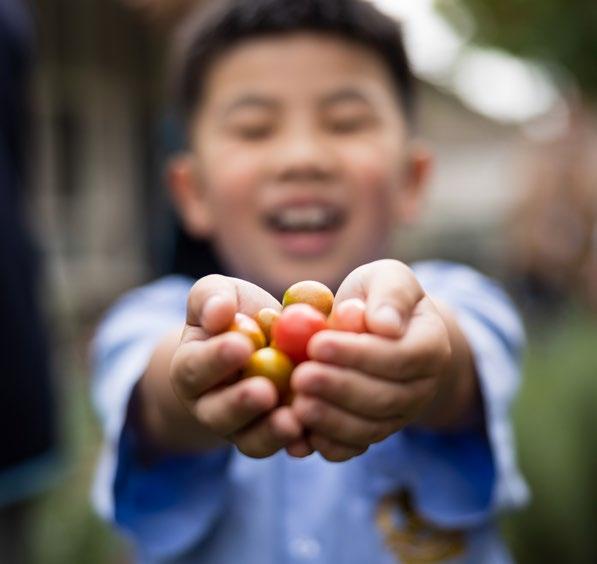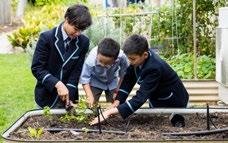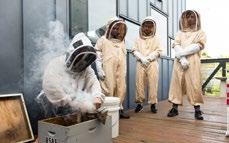
5 minute read
Towards Target Zero
Looking to the future, our Sustainability Coordinator, Mr Will Hone, shares the roadmap our School has embarked upon as we move towards carbon zero operations by 2030. With many exciting plans in progress to become a greener and more sustainable school, Mr Hone outlines the great environmental initiatives that the School has already implemented and those that are coming in the years ahead.
Schools are, on the face of it, heavily invested in the future. We teach kids – the oft-invoked next generation – how to explore, comprehend, and work with the world around them. In 2022, it is – unfortunately – very difficult to consider the future without contemplating the climate crisis.
The climate crisis is challenging – it is a huge issue facing the world, and we are just a school. So like anyone, we do our best to improve ourselves in ways that we hope will make a difference. Against this backdrop, there have been many projects over the past seven years that aim to reduce the School’s footprint, largely focused on waste and energy.
But we needed a plan to see where we are, where we are going, and what we should do to get there as efficiently as possible. So we are getting a map drawn up. It’s a proper map and it’s really exciting, and it is this map, its rationale, and its direction that is the subject of this article.

Here’s what happens when I have an idea. I get excited and jump around a lot and start talking to people – I’m annoying like that. I talk to the Headmaster, the business Manager, and the Property Manager. I talk to the wonderful people in the Community and Development Office, and beleaguered people who share the English office with me, and I talk to the students in my classes. I talk a lot.
This means that when an idea starts bubbling in my head, it tends to come frothing into the world amidst a tsunami of words and waving arms which was very much the case last year. We needed a map (I kept telling everyone with half an ear to listen) to illustrate our commitment and make clear the path we plan to follow – and carbon neutrality was like the blue line on Google Maps, leading us through the maze of accreditation programs and certificates.
To draw this together under an umbrella project, towards the end of last year the School Council made a commitment to have carbon zero operations by 2030 and to be climate positive as we move forward. Indeed, their response was extraordinary – they were genuinely excited by the prospect of the School committing to action on the climate crisis, and since then we have signed on with a professional consultant to help us understand our operations in detail to ensure we make good on our word. The School Council could see that this is the future, and the future is, of course, our core business.

There are many terms used to describe emissions reductions. They are terms that we frequently hear, but which bear some explaining. becoming carbon zero means reducing our impact as much as possible in waste, energy, and transport, and buying carbon credits to offset the remaining emissions. Our solar array, for example, is now fully complemented by renewable energy – every light at Camberwell Grammar, every computer and microphone is powered by renewable energy (we’re pretty wrapped about this!). but energy is just one edge of the puzzle – and we are committed to working on our operations holistically – we are addressing waste and transport, starting with an auditing process this year.
There is more to a school than smokestacks of carbon, though – this is, after all, more than an exercise in accounting. becoming climate positive means we are also working on our water use and the biodiversity of our campus – while these aspects of sustainability do not necessarily involve carbon dioxide, it is not possible to care about the future and short change the environment at the same time. We are attempting to create a positive pathway into the future and to illustrate to our students and our community that positive and convenient solutions to our problems do exist and can be found. This means there are many projects on the horizon. We have cut the amount of landfill produced by the School from 30m3/week in 2017 to 12m3/week at the moment – and we need to cut it in half again, which involves significant shifts in our operations. We are working on our water usage, installing water-saving appliances and reviewing our water network to iron out inefficiencies. And we are working to bring our community with us on the journey – we want to present opportunities and solutions that will easily fit into the annual routine of education on campus, and life at home.
We are embracing the challenges before us – what else can we do? In doing so we are searching for solutions that not only fit, but help us evolve as a community to be ready to face whatever the decades to come have in store. There is, clearly, a lot more to this place than meets the eye – our investment in the future is not skin deep, it is in the bones of the School, and long may it remain so.

Mr Will Hone
Sustainability Coordinator









